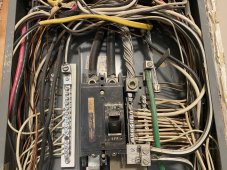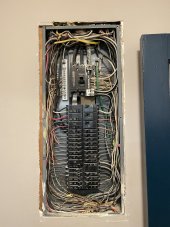TurbineTester
New Member
- Joined
- Apr 1, 2021
- Messages
- 143
I just a had a weird experience. We recently installed 36 panels on two different roofs. Main house (27) and Garage (9). have two EG4 6500EX inverters in the garage powering a sub panel in the garage for now. These two inverters are not playing well with each other in split phase mode (https://diysolarforum.com/threads/eg4-6500-power-output-problem.43408/page-3#post-644580). So i just ran one inverter in single phase mode. I have my son installing gutter guards on the gutters and he had been having the ladder on the concrete. But he moved it so the feet were in the flower bed between the house and garage and said he "felt a tingle" when he got to the top of the ladder and was touching the roof. So i got up there with my volt meter and sure enough there was about ~177v AC potential between the ladder and the roof. I checked for DC potential as well and found nothing. When i turned the inverters off, the votage went away. I can see no possible way that i have a short between any AC output and the roof of my garage. It's a metal roof but vinyl siding and wood framing on concrete slab. The only way the roof itself is grounded is through the gutter downspouts. All the inverter output goes directly to the sub panel where the NG is bonded in the panel as far as i can tell. There is one 10ga wire run from my main panel to the sub panel in the garage that is wired into the same panel as the inverter but it is on a separate breaker that is not energized currently. I only have this as a way to power the garage until we get the split phase problem sorted out with the EX inverters . However that 10ga wire from the house has neutral and ground connected in the sub panel, if that is relevant. So the NG from the house is bonded to all NG in the subpanel, even when the breaker in the subpanel is off. My main electrical service is grounded within 10 feet of this subpanel, and the main service panel in my house is less than 10' from the ground rods. The 10ga wire from the main panel to the garage is 4 conductors, L1 L2 N G. When i disconnect athe N and G from the sub panel the voltage on the roof goes down from ~177 to around 60V. When either the N or G of the 10ga wire is connected back to the sub panel the voltage goes back to 177. If i disconnected the PV array from the Inverter the voltage goes to 0ish (1-5v). If i leave the PV array connected but put the interver in standby the voltage goes to 0 (1-5V). At this point i'm measuring the voltage by putting the negative probe of my Klein MM in the wet dirt and the postive probe on the gutter down spout. I don't know that any of this other information is relevant at this time but i'm trying to figure out hwo the heck i'm getting live voltage on my metal roof. Any help is appreciated.






